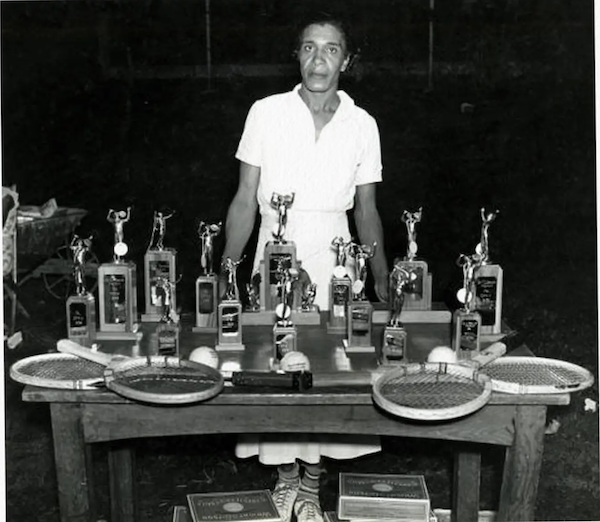
Ora Washington with her many tennis awards. Credit...John W. Mosley/Temple University Libraries, Charles L. Blockson Afro-American Collection
Black tennis was strong during the 1930s and 1940s, among women as well as men players.
Isadore Channels was the leading female player in the early 1920s, winning four American Tennis Association [ATA] national singles championships between 1922 and 1925. She was replaced by Ora Washington, who defeated her in a match in 1925 when Channels was the reigning ATA champion.
Ora Washington was one of the all-time great athletes, performing as one of the country’s best basketball and tennis players simultaneously. Washington was inducted into the Women’s Basketball Hall of Fame in 2009 and the Basketball Hall of Fame in 2018.
Washington started her basketball career with a YMCA team in 1930, the Germantown Hornets. The team broke away from the YMCA in 1931 and became a semi-pro team, which won the black national championship that year. Their opponents included African American women’s teams, white women’s teams, and occasionally African American men’s teams.
The Tribune Girls team sponsored by the Philadelphia Tribune newspaper hired Washington away from the Hornets. Over the next 12 years, Ora Washington and the Tribune Girls barnstormed up and down the east coast and in the South and Midwest. They had no rivals, and Ora was their star. Ora continued to play basketball until 1943 when the Tribune Girls were disbanded.
Meanwhile, Ora kept winning on the tennis court. She took home the ATA singles title eight times in the nine years between 1929 and 1937. And then, in 1938, she retired from singles.
The up-and-coming star was a woman named Flora Lomax. She drew a lot of positive attention as she was a “refined” young lady from the upper middle class. So, Ora unretires for one match. Then, she goes to a tournament in Buffalo specifically to play Flora Lomax. Ora beats her, and then she retires again.
Ora won her last national doubles tennis title in 1947, defeating Walter Johnson and the upcoming superstar Althea Gibson. And then she disappeared from the public.
Washington never played the top white tennis player of the time, Helen Wills Moody, because Moody refused to schedule a match. Ora Washington was undoubtedly one of the best tennis players of all time.
Two events during this time might indicate the importance of tennis among African Americans. The first was FDR’s depression-era project, the Works Progress Administration, building hundreds of public courts in parks where blacks played. The second, in 1938, was the ATA sending players on a tour of 21 colleges and eight high schools to boost the quality of play at these places.
Related:
Black Tennis — Part I
Serena Williams forced sports journalists to get out of the ‘toy box’ – and cover tennis as more than a game
In 1940, in the rigidly segregated world of tennis, the top ATA player, Jimmy McDaniel from California, played an exhibition match at the black club in Harlem against the great Donald Budge who was white. During the !930s and early 1940s, Budge was the best player in the United States and is often regarded as the best American player of all time. He was the first of the handful of players who won the Grand Slam of tennis– all four majors in one year. Budge won the match against McDaniel and then teamed with Reginald Weir in a doubles match against McDaniel and Richard Cohen, the reigning ATA doubles champions.
The next big thing in black tennis was the great Althea Gibson in the 1940s and 1950s, followed by Arthur Ashe in the 1960s and the 1970s. Significantly, the ATA was instrumental in the development of the careers of each of these important players.
• • •• • •
Wornie Reed is Professor Emeritus of Sociology and Africana Studies and Director of the Race and Social Policy Research Center at Virginia Tech University. Previously he developed and directed the Urban Child Research Center in the Maxine Goodman Levin College of Urban Affairs at Cleveland State University (1991-2001), where he was also Professor of Sociology and Urban Studies (1991-2004). He was Adjunct Professor at the Case Western Reserve University School of Medicine (2003-4). Professor Reed served a three-year term (1990-92) as President of the National Congress of Black Faculty, and he is past president of the National Association of Black Sociologists (2000-01).
This column first appeared online at What the Data Say and is shared here by permission.
EDITOR's Note: for more on Ora Washington [1899-1971], see here, here and here.














